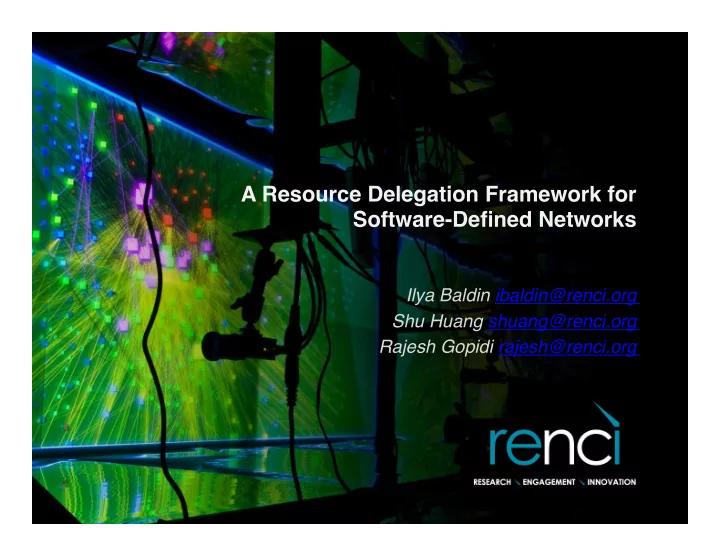

A Resource Delegation Framework for Software-Defined Networks � Ilya Baldin ibaldin@renci.org � Shu Huang shuang@renci.org � Rajesh Gopidi rajesh@renci.org � �
The Problem � B A E F D C • Offering network services in a multi-domain environment � • In SDN environment primarily boils down to � – Controller coordination for provisioning (e.g. DISCO) � – ‘Big-switch’ abstractions � • What we would like � – Offer heterogeneous network services (QoS, resiliency, virtual networks) across many providers � – Allow providers to trust ‘alien’ controllers � – Support nested virtualization � – Separate resource management from provisioning � • Split off coordination of resource allocation on long term scale from short-term provisioning � 2 � This ¡work ¡is ¡funded ¡by ¡DOE ¡ASCR ¡award ¡DE-‑SC0007425 ¡and ¡NSF ¡grant ¡ ¡CNS-‑1111256 ¡ ¡
The Overview � • Multi-domain environment where customers use ‘services’ (connections or virtual networks) � – Different QoS requirements (latency, bandwidth, resiliency, isolation) � – E.g. the Internet can be one of the overlays � B A E F D C Presentation title goes here � 3 �
The Problem Formulation � • Label � – Labels can be translated in some points in the network � • Technology level � – Binds to a label offset or type. � – Technology levels have a partial order where A < B indicates B can enclose A and carry its traffic � – E.g. 802.3 > IP (not necessarily OSI-compliant) � • Label extents within technology levels are defined per port, per network element along with other consumable resources � – Outgoing bandwidth, Buffer space, Flow table space � • Represent multi-dimensional spaces that can be tested for inclusion/intersection � • A portion of such volume represents a delegation of resources � – Can be used by a controller to form forwarding rules managing traffic � – Can be further subdivided to create nested delegations � 4 �
Example � • Constraints are needed to describe delegations � – Volume inclusion � – Path/label continuity � – Label/bandwidth accounting � • ILP formulation in the paper � Dt Customer ¡View ¡ X Y A E d 1,2,3 1,5,6 C 1 1 Provider ¡View ¡ 1 1 Dt c A B D E 2 2 5 5 3 6 3 6 5 �
The Architecture � • Form and describe RESOURCE CONTROLLER MANAGER delegations � AUTHORIZATION – Resource manager � RESOURCE FRAMEWORK CONTROLLER MANAGER – Coordinated by customer, RESOURCE MANAGER directly or via broker � CONTROLLER • Inform controllers � Flow Space Manager – Controllers know the constraints � Network Element • Enforce delegations on behalf of providers at switch level � – PDP vs. PEP � – Flow space manager � • Pervasive Authz � 6 �
The Prototype � • Delegation framework � – GUI tool to form reservations and describe using GraphDB � – Floodlight module to accept these descriptions � • Sample multi-domain application � – Virtual transport provider built out of 3 other providers (virtual or physical) � – Provides transport path-based services using a portion of L2 MAC address field delegated to it for path identification � • Tested in a GENI slice � 7 �
The Experiment � B 5 C 8 6 4 A 2 9 7 3 1 Transport Provider D 8 6 4 2 9 7 3 1 8 �
The Experiment (GENI Slice) � 9 �
The Prototype Modules in Floodlight � • Topology delegation � – Accepts constrained delegation descriptions in GraphDB � • Topology verification � – Uses stochastic probing across delegated label space to verify connectivity � – LLDP not suitable for this purpose � • ARP Resolution � – Listens for client ARP requests � – Performs substitution of MAC address with Path IDs � • Circuit computation � – Computes paths and assigns path IDs � 10 �
Outcomes � • Direct control over provider equipment with verifiable constraints � • Explicit communication of constraints to controllers � • Nested virtualization � • Efficient use of label spaces � • Dynamic resource allocation � • Multiple approaches in one architecture � • Support for an economy � 11 �
Recommend
More recommend